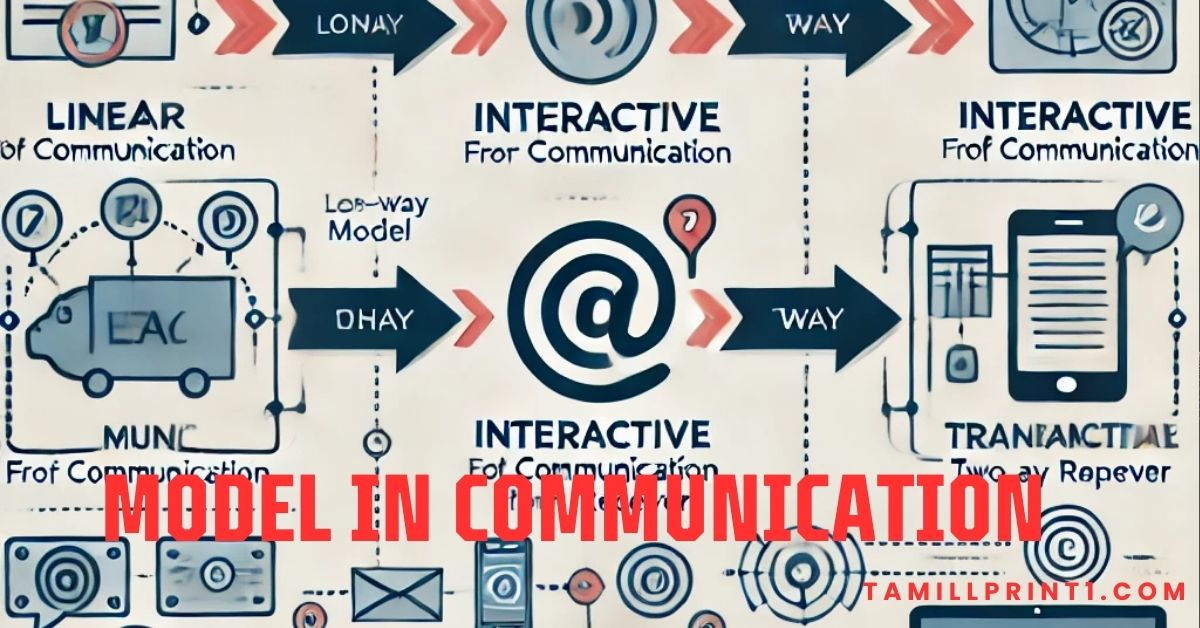Communication is the backbone of human interaction, enabling us to share thoughts, ideas, and emotions. To understand how communication works, experts have developed various models that simplify and explain the process. A model in communication provides a visual or conceptual representation of how messages are transmitted, received, and interpreted.
This comprehensive guide explores different models of communication, their importance, and how they apply to everyday situations. Whether you’re a student, professional, or researcher, this article will help you grasp the essence of communication models with easy-to-understand explanations and examples.
What is a Model in Communication?
A model in communication is a structured representation that explains how communication occurs. It helps in understanding the roles of the sender, receiver, message, channel, feedback, noise, and context in the communication process. These models range from simple linear frameworks to complex interactive systems that account for various influencing factors.

Key Elements of Communication Models:
Every model consists of essential elements that play a role in the communication process:
- Sender: The individual or entity initiating the message.
- Message: The information being communicated.
- Channel: The medium through which the message is delivered (e.g., verbal, written, digital, face-to-face).
- Receiver: The person or group that interprets the message.
- Feedback: The response given by the receiver to indicate message understanding.
- Noise: Any interference that disrupts the communication process.
- Context: The environment or background factors affecting communication.
By understanding these elements, we can analyze different communication models more effectively.
Also Read: EJU4857: A Complete Guide to Your Journey
Importance of Communication Models
Models of communication are crucial because they:
- Simplify complex interactions: By breaking down communication into key components, models help us understand how messages are conveyed.
- Improve communication skills: Understanding these models can help individuals enhance their verbal and non-verbal communication abilities.
- Aid in problem-solving: Models help identify communication barriers and suggest ways to overcome them.
- Support academic and professional studies: These models are widely used in linguistics, media studies, business communication, and psychology.
- Enhance workplace efficiency: Organizations use communication models to develop effective communication strategies within teams and departments.
Types of Models in Communication
Communication models are classified into three main categories: linear, interactive, and transactional. Below, we explore each type in detail.
1. Linear Model of Communication
The linear model of communication is the simplest form, where communication flows in one direction, from sender to receiver. This model does not account for feedback or interaction.
Also Read: Work in Nuzillspex Advisors Ltd: A Complete Guide to Careers and Opportunities
Key Elements:
- Sender: The source of the message
- Message: The information being transmitted
- Channel: The medium used (e.g., text, speech, email)
- Receiver: The person who receives the message
- Noise: Any interference that affects message clarity
Characteristics of the Linear Model:
- One-way process: There is no response from the receiver.
- Simple and direct: Ideal for mass communication like television and radio broadcasts.
- Ignores feedback: The receiver has no opportunity to respond.
Examples:
- A radio broadcast
- A public speech
- A TV advertisement
Notable Linear Models:
- Shannon-Weaver Model (1949): Focuses on information transmission and the effect of noise on communication.
- Lasswell’s Model (1948): Describes communication using the formula “Who says what, in which channel, to whom, with what effect?”
2. Interactive Model of Communication
The interactive model of communication acknowledges that communication is a two-way process involving feedback and shared experiences.
Key Elements:
- Sender & Receiver: Both take turns sending and receiving messages.
- Feedback: Response from the receiver that confirms message reception.
- Context: The environment or situation affecting communication.
- Noise: Interference that may distort the message.
Characteristics of the Interactive Model:
- Two-way communication: Allows for feedback, unlike the linear model.
- Accounts for experience: Shared knowledge affects message understanding.
- Recognizes external factors: Context and noise influence interpretation.
Examples:
- Email exchanges
- Teacher-student interactions
- Social media conversations
Notable Interactive Models:
- Schramm’s Model (1954): Introduces the concept of “field of experience,” meaning shared background knowledge affects understanding.
Also Read: About Holl78zunhot: Revolutionizing Social Networking with AI
3. Transactional Model of Communication
The transactional model of communication sees communication as a continuous, dynamic process where all participants are both senders and receivers simultaneously.
Key Elements:
- Simultaneous communication: Messages are sent and received at the same time.
- Context: The physical, cultural, and psychological environment influencing communication.
- Noise: Any factor that affects communication.
- Feedback Loop: Instant responses that shape the conversation.
Characteristics of the Transactional Model:
- Real-life applicability: Reflects natural conversations where individuals exchange messages continuously.
- Accounts for multiple factors: Includes verbal and non-verbal communication.
- Emphasizes mutual influence: Both parties shape the conversation.
Examples:
- Face-to-face conversations
- Video calls
- Group discussions
Notable Transactional Models:
- Barnlund’s Transactional Model (1970): Highlights the continuous exchange of messages and mutual influence between communicators.
Real-Life Applications of Communication Models
Understanding models in communication helps improve various aspects of life, including:
- Business Communication: Effective workplace communication relies on interactive and transactional models.
- Education: Teachers use interactive models to engage students and ensure better learning outcomes.
- Mass Media: The linear model explains how information is transmitted through TV, newspapers, and online media.
- Personal Relationships: The transactional model emphasizes the role of continuous dialogue in maintaining relationships.
- Healthcare Communication: Doctors and patients benefit from interactive models to ensure clear understanding of medical information.
Also Read: Haktv2killponx: A Comprehensive Analysis of Its Origins, Impact, and Future Trends
Challenges in Communication Models
Despite their usefulness, communication models have limitations:
- Oversimplification: No model fully captures the complexity of real-life communication.
- Lack of Emotional Aspects: Many models focus on structure rather than emotions and human perception.
- Context Variability: Different contexts may require different communication approaches.
- Technological Barriers: With digital communication, traditional models may not fully apply.
FAQs About Model in Communication
What is the best model of communication?
There is no single “best” model; it depends on the context. The linear model is effective for mass communication, the interactive model suits educational and professional interactions, and the transactional model is ideal for personal communication.
Why is the transactional model considered the most realistic?
The transactional model reflects real-life communication best because it acknowledges that communication is dynamic, involves feedback, and considers multiple influencing factors.
How do communication models help in daily life?
They improve understanding, enhance interpersonal skills, and assist in professional settings like marketing, teaching, and management.
Can communication models apply to digital communication?
Yes, models like the interactive and transactional models are highly applicable to emails, video calls, and social media conversations.
What are common barriers in communication models?
Noise, cultural differences, emotional factors, and lack of feedback can hinder effective communication.
Conclusion
A model in communication provides a structured way to understand how messages are conveyed and received. Whether you are studying communication, working in media, or improving your interpersonal skills, knowing these models can help you communicate more effectively. By recognizing the strengths and limitations of different communication models, you can adapt your approach to different situations, enhancing both personal and professional interactions.
Understanding and applying these models can transform the way you communicate, making your interactions clearer, more effective, and more impactful.







